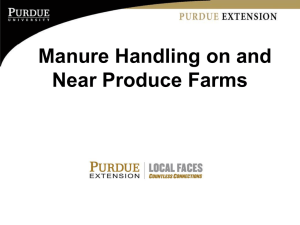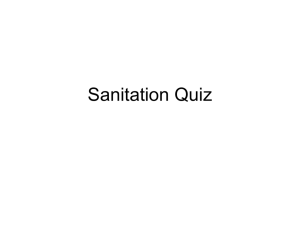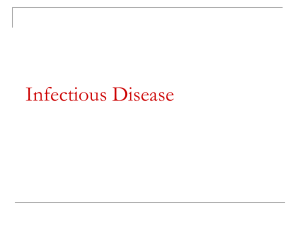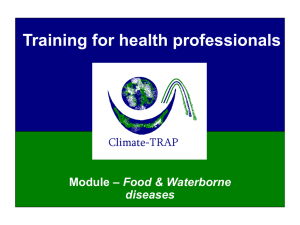Food Safety
advertisement
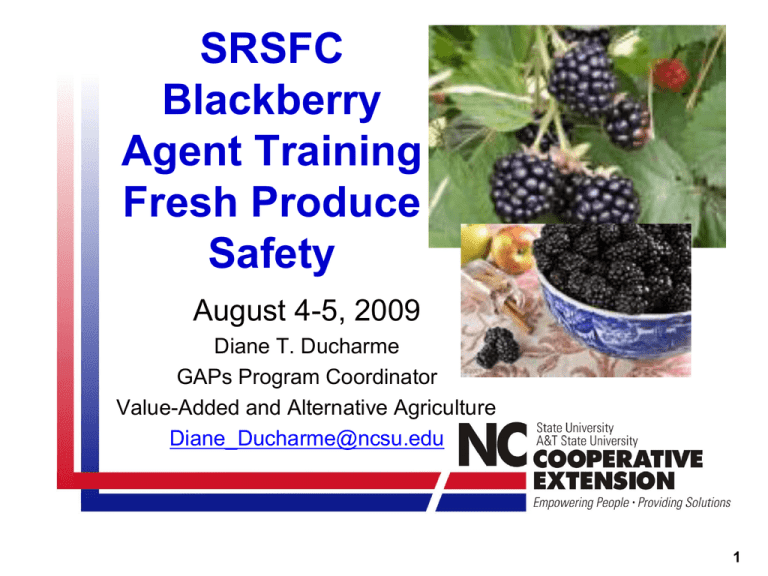
SRSFC Blackberry Agent Training Fresh Produce Safety August 4-5, 2009 Diane T. Ducharme GAPs Program Coordinator Value-Added and Alternative Agriculture Diane_Ducharme@ncsu.edu 1 Good Agricultural Practices (GAPs) • A tool for addressing food safety (human pathogens) on the farm • A voluntary program (now) • Eight (8) recommended practices 2 Blackberries and GAPs • Fresh fruit • Field-packed without washing • Primarily found cases of Cyclospora Cayetanensis on raspberries • Prevention is key! 3 Topics • Framework for GAPs • What are the pathogens of concern? • How does contamination happen? • GAPs/GHPs/GMPs/HACCP • Self-certification • Food Safety Plans 4 What Are the Challenges Associated with Fresh Produce? • Contamination persists from farm to fork. • Education of produce handlers, retailers, through to consumers. • Fresh produce – no kill step • “Guilty by association until proven otherwise” 5 Why Should We Care? Every year, about 76 million cases of foodborne illnesses result in an estimated: • 325,000 hospitalizations • 5,200 needless deaths • Economic losses between $10-83 billion A recent study suggested that producerelated illnesses accounted for the largest number of cases -- 29 percent. 6 Number of Produce-Related Outbreaks by Decade, 1973 - 2008 14 Outbreaks / year 12.6 12 10.5 10 8 6.5 6 4 3.7 2 0 1973-79 1980-89 1990-97 1998-2008 Decade Source: CDC 7 Why Have Produce-Related Human Infections Increased? • Higher per capita consumption • Advances in microbial detection methods • New packaging technology for longer postharvest shelf life • Global sourcing • Evolution of new, more virulent pathogens • Produce often not cooked before consumption 8 Courtesy of William C. Hurst, UGA Produce-Associated Outbreaks Affect Business • Strawberry industry lost an estimated $50 million in 1996 after mistakenly being indicated as the source of pathogens in an outbreak. • Apple juice (Odwalla Inc.) shareholder value dropped approximately 41 percent ($12.4 million) in six months after E. coli O157:H7 outbreak in 1996. • Outbreaks reduce effectiveness of produce-promotion campaigns. • Outbreaks may result in unwanted legislation or regulation. 9 Most Commonly Implicated Produce Items • • • • • Leafy greens Tomatoes Sprouts Berries Melons 10 Pathogens of Concern • Bacteria – Singlecelled organisms that live independently • Viruses – Small particles that live and replicate in a host • Parasites – Intestinal worms or protozoa that live in a host animal or human Bacteria Viruses Parasites 11 Bacteria and Outbreaks Associated with Produce E. coli 0157:H7 Iceberg lettuce, radish sprouts, unpasteurized apple cider/juice, spinach Salmonella spp. Tomatoes, bean sprouts, sliced watermelon, sliced cantaloupe, coleslaw, onions, alfalfa sprouts, root vegetables, dried seaweed, hot peppers L. monocytogenes Cabbage, lettuce B. cereus Sprouts 12 Viruses and Outbreaks Associated with Produce Hepatitis A Iceberg lettuce, raspberries, virus strawberries, green onion Norovirus Lettuce 13 Parasites and Outbreaks Associated with Produce Cryptosporidium Apple cider Cyclospora Raspberries 14 Case Study: Cyclospora on Raspberries • Pesticide water fecal contamination ? • Contamination during hand-sorting & packing (sporulation)? • Bird droppings? • Other risk factors included – water source, type of sewage drainage, ownership of chickens or other fowl, and contact with soil (among children younger than 2 years • Epidemiologic Studies of Cyclospora cayetanensis in Guatemala (http://www.cdc.gov/ncidod/eid/vol5no6/pdf/bern.pdf) Bern, et al12/99) 15 Where Do These Microbial Pathogens Normally Live? Inhabitants of soil • Listeria monocytogenes • Bacillus cereus • Clostridium botulinum 16 Where Do These Microbial Pathogens Normally Live? Residents of human and animal intestinal tracts • Salmonella • E. coli O157:H7 • Shigella • Campylobacter Courtesy of Cornell University • Viruses 17 Where Do Pathogens Attach? JFP vol65 p18-23 18 Produce Wash-Water Solutions 19 Pathogen Management Throughout the Fresh Produce Chain • Preharvest • Production • Harvest • Post-harvest handling • Transportation 20 1-21 Eight Principles of Good Agricultural Practices 1. 2. 3. 4. 5. 6. 7. 8. Prevent microbial contamination Start program of GAPs Human/animal feces Water Animal manure Worker hygiene/sanitation Follow all applicable laws Traceback/recordkeeping/documentation 22 GOOD AGRICULTURAL PRACTICE #1 Preventing microbial contamination of fresh produce is favored over relying on corrective action once contamination occurs. 1-23 Site Selection • Has the site been exposed to activities or conditions in the past that might have resulted in contamination? • Is adjacent land being used for purposes that might result in contamination of crop land? 24 Site Selection • Land use history – Livestock or manure – Flooding – Hazardous chemicals • Current proximity to livestock operations, cull piles, refuse dumps and debris 25 Site Selection •Farm layout •Farm diagram •Feedlot drains into irrigation pond t 26 Site Selection • Soil can be tested for fecal bacteria, heavy metals or chemical contamination. • Fecal coliforms or E. coli are often used as indicators of contamination by manure or sewage. 27 GOOD AGRICULTURAL PRACTICE #2 To minimize microbial food safety hazards in fresh produce, growers, packers or shippers should use good agricultural or management practices in those areas over which they have control. 1-28 GOOD AGRICULTURAL PRACTICE #3 Fresh produce can become microbiologically contaminated at any point along the farm-to-table food chain. The major source of microbial contamination with fresh produce is associated with human or animal feces. (proximity) 1-29 Animal Hazards • Animal feces are a main source for pathogenic organisms • Since animals are in contact with soil, manure and water, they can easily pick up contaminants from these sources • Some pathogenic bacteria commonly found on animals include Salmonella, Staphylococcus and Streptococcus • Maintain records of pest control program 35 Blackberry for the Birds? 36 Wild & Domestic Animals • Man’s best friend • Exclude/Buffers • Scout for damage/signs – Discrete white blotch left behind • Management of runoff from livestock production area • Management of water resources 1-32 Human Waste Management 33 GOOD AGRICULTURAL PRACTICE #4 Whenever water comes in contact with produce, water quality dictates the potential for produce contamination. Minimize the potential for microbial contamination from water used with fresh fruits and vegetables. 1-34 Water Pre-harvest Irrigation/Frost control Pesticide or nutrient sprays Worker drinking water Facilities – restrooms and handwashing Harvest & packing Dump, wash, rinse, cool Drinking water Cleaning and sanitation water Cooling and Transporting Ice Cleaning and sanitation water Irrigation drip vs overhead 36 Irrigation Practices • Surface water may contain pathogens and parasites of humans • Well (ground) water is less likely to harbor pathogens, depending on depth, but may contain pesticide residues or heavy metals • Water sources should be tested for generic E.coli and chemicals 37 Pesticide Application • Crops can become directly contaminated with pesticides if improperly applied. • Crops can become directly contaminated with pathogens if water used to mix pesticides is contaminated. • Use potable water when pesticides will come in direct contact with harvested fruit 38 • Runoff from fields containing livestock manure can contaminate surface water with pathogens as well as with nutrients. • Algal blooms are a symptom of a potential problem. Runoff 39 Keep Grazing Animals 30 Feet from Water Source 40 Livestock in watering source? • Exclude animals from surface water sources as well as from drainages to water sources. 41 Microbiological Testing Considerations for Agricultural Water • Microbiological testing is used to track safety, not for daily monitoring activities. • Records become very important in the event of a microbiological outbreak investigation. • Document the frequency and results of each water test for comparison purposes. Changes may help identify problems. 42 Water Source Will Determine the Possible Frequency of Testing Source Municipal/District water system Possible Water Testing Frequency Test annually and keep records from the municipality/district water system (monthly, quarterly or annual report) Closed system, under the One annual test at the beginning of season ground or covered tank Uncovered well, open canal, water reservoir, collection pond Every month during the production season 43 Indicator Organisms • Total coliform • Fecal coliform • Generic E. coli 44 Water-Quality Considerations for Pre-harvest Irrigation • Where edible portions of the crop ARE NOT contacted by water: – Generic E.coli sample parameter • Acceptance Criteria: Less than or equal to 126 MPN/100mL (geometric mean of five samples) • Acceptance Criteria: Less than or equal to 576 MPN/100mL (for any single sample) 45 Water Quality Considerations for Preharvest Irrigation • Where edible portions of the crop ARE contacted by water – Generic E.coli sample parameter • Acceptance Criteria: Less than or equal to 126 MPN/100mL (rolling geometric mean n=5) • Acceptance Criteria: Less than or equal to 235 MPN/100mL (for any single sample) 46 Water Quality Consideration of Postharvest Water • Water in direct contact with produce should meet EPA MCLG microbial drinking water quality standards. – Generic E. coli negative test or below detection limit • If not, remediation is needed (disinfect). – >1 ppm free chlorine (pH 6.5-7.5) or ≥ 650 mV ORP (pH 6.5 – 7.5) – Other approved water treatments for human pathogen removal (EPA labeled) 47 Adulterated Produce • FDA considers any crop that has come into contact with floodwater to be an “adulterated” commodity that cannot be sold for human consumption. 48 GOOD AGRICULTURAL PRACTICE #5 Practices using animal manure or municipal biosolid wastes should be managed closely to minimize the potential for microbial contamination for fresh produce. (120 days) 1-49 Pathogens • Spread onto surface of plants from amendment or amended soil (possibly to inside of fruit) • Uptake by roots 50 Raw Manure • Apply early, keeping nutrient concerns in mind. • Don’t apply manure or manure-containing litter while eaten part is present. • Cornell GAPs suggest applying and incorporating manure at least 120 days before harvest. 51 Raw Manure • A DENR permit is required for manure disposal if owners have at least: – 75 horses – or 100 dairy cows – or 250 hogs – or 1,000 sheep – or 30,000 broilers or layers (liquid waste systems) 52 Manure Treatment Methods • Aging (passive) • Composting (active) • Other active treatments – Pasteurization – Heat drying – Aerobic and anaerobic digestion – Alkali stabilization 53 Composted Manure Composting guidelines often based on federal biosolids law (40CFR503): • At or above 131°F for at least three (within-vessel or static aerated pile) or 15 (windrow) days • Turned at least five times (windrow only) 54 Manure Storage • Manure should not be placed or stored where runoff from the storage location is likely to contaminate water sources. 55 GOOD AGRICULTURAL PRACTICE #6 Worker hygiene and sanitation practices during production, harvesting, sorting,packing and transport play a critical role in minimizing the potential for microbial contamination of fresh produce. 1-56 Personal Health and Hygiene • The major source of human pathogens are worker’s hands, so the single most effective public health measure to disease prevention is proper hand washing. 57 Proper hand-washing is the best method of reducing contamination Probably the #1 source of food-borne illness is unsanitary worker conditions 58 When Hands Should Be Washed • Before beginning work • After each restroom visit • Before and after eating/smoking/other breaks • After other activities not including produce handling • Anytime hands become dirty 59 How to Wash Hands Properly • Remove rings/watches/bracelets. • Use warm running water. • Use antibacterial soap. Lather hands, wrists, fingers. Don’t forget to scrub your thumbs, under your nails and in between your fingers. Wash your hands for 20 seconds. Fully dry out your hands with disposable paper towel. 60 Single-Use Gloves • Can be an added hygienic practice, if used properly. • Is especially useful with wounds and open sores • Can be a vehicle for transferring surface germs. • Must be used in combination with proper hand washing. • Must be discarded, hands washed and new gloves changed each time the wearer needs to wash hands. 61 Other Protective Practices • Hair nets or ball caps • Clean aprons • Clean shirts, pants or other worker clothing • Absence of jewelry • Correct foot wear 62 How Do Pathogens Get Transferred? • • • • • • Human-to-human/produce contact Human-to-soil contact Soil-to-produce contact Container/equipment-to-soil contact Contaminated water contact Improper sanitation – Oral-fecal contact – Produce-fecal contact 63 Signs of Sudden Illness • • • • • • • • • • • • • Changes in consciousness Nausea or vomiting Difficulty speaking or slurred speech Numbness or weakness Loss of vision or blurred vision Changes in breathing Changes in the skin color Sweating Persistent pressure or pain Diarrhea Seizures Paralysis or inability to move Severe headache 64 Restroom and Hand-Washing Facilities • According to OSHA regulations, one toilet facility and one hand-washing facility shall be provided for up to 20 employees. • Facilities shall be located within a onequarter-mile walk of each hand laborer’s place of work. 65 Sewage Disposal • Improper disposal of human waste from toilets could lead to contamination of water, soil, animal, crop or worker. • Use caution when servicing portable toilets: – Sewage transport trucks need direct access to toilet facilities to ensure proper collection and disposal of wastes. • Operators should be made aware of and be prepared in the event of any incidence of leakage or spillage of effluent in a field. 66 Visitors Should Also Follow Good Hygiene Practices • Operators should require that product inspectors, buyers and other visitors comply with established hygienic practices whenever they come into contact with fresh produce. • All visitors should have easy access to a clean facility, plenty of good quality water, soap, and paper towels. • When necessary, visitors should wear appropriate, safe footwear for working in the fields. • As a way of better protecting North Carolinians from food-borne diseases, customers should be encouraged always to wash all of their produce. 67 Restrooms and Hand-Washing Facilities 68 How Can Growers Prevent Produce Contamination by Employees? Educate employees about: • Pathogens • Pathogen origins • How pathogens can spread • Symptoms of food-borne illnesses • Health and hygiene policies and practices 69 Field Hazards • Field Hazards include contact with: – Soil – Fertilizers – Water – Workers – Harvesting Equipment – Animals, birds, and insects Courtesy of70 FDA GOOD AGRICULTURAL PRACTICE #7 Follow all applicable local, state, and Federal laws and regulations, or corresponding or similar laws, regulations, or standards for operators outside the U.S. for agricultural practices. 1-71 GOOD AGRICULTURAL PRACTICE #8 • Accountability at all levels of the agricultural environment (farm, packing facility, distribution center and transport operation) is important to a successful food safety program. This includes trace produce back/forward, recordkeeping, and documentation. 1-72 Or………One step back One step forward • “Who/Where I got it from & Who/Where is it going” • A traceback investigation is the method used to determine and document the distribution and production chain, and the source(s) of a product that has been implicated in a foodborne illness investigation, quickly and accurately. More info on 21 CFR part 1, subpart J: http://www.accessdata.fda.gov/scripts/cdrh/cfdocs/cfcfr/CFRSearch.cfm 73 Why is this important? – Quickly & accurately = locate foods in the distribution system – Quickly & accurately = prevent illnesses and possible deaths – Quickly & accurately = allow for integration of other existing program requirements – Quickly & accurately = less economic impact to growers 74 the consumer speaks…. • Food scares erode confidence in food safety. – 46 percent worry about getting sick from food. – 52 percent have only some or little confidence in the food inspection system. • Consumers support traceability solutions. – 86 percent support labeling produce so it can be tracked. – 80 percent support federal safety standards for produce. – 92 percent support COOL. • Sources: AP-Ipsos poll July 18, 2008; Harvard School of Public Health poll June 12, 2008; • Consumers Reports survey July 10, 2007. 75 Country of Origin Labeling • Or COOL • 2008 Farm Bill extended to: – Beef, pork, lamb, goat, chicken, fresh/frozen fruit & vegetables, peanut, pecan, ginseng, and macadamia nuts • COOL information includes: – Producer affidavits – Purchasing/receiving records – Production/harvest records 76 Bioterrorism Act (2002) sets forth the establishment and maintenance of records for persons who manufacture, process, pack, transport, distribute, receive, hold, or import food in the US (21CFR part 1, subpart J) “Generally, everybody in supply chain must be able to trace one step back and one step forward” 77 Traceback includes a: • A documented traceback program has been established. • Finished product is traceable to: – the packinghouse – a group of growers/the specific grower – a group of orchards or fields/to the specific orchard or field. – a group of harvest dates/a specific harvest date – identified with a packing date • The operation has performed a “mock recall” was proven to be effective. 78 Internal + External = Whole-Chain Traceability • Internal = confidential or proprietary data and processes companies use within their own span of operations to track/trace product. (e.g. packer) • External = the data exchange and business processes that take place between trading partners to track/trace product. (grower => packer => retailer) 79 80 Self Certification • Means going through the process of food safety on the farm • No cost • No Certification to show end marketers • www.ncfreshproducesafety.org – Audit resources 81 1-82 3rd Party Audits • Annual Certification – During growing season • Costs - Ave. $300-600/farm • Defined as a neutral party to audit a defined process or procedure • Auditors – – – – Primus Labs AIB Others USDA 83 GAP Audit Criteria • One to Eight Parts to audit- 80% passing – DON”T HAVE TO HAVE ALL 8! General Farm – – – – – – Part 1 – Farm Review Part 2 - Field Harvest and Field Packing Activities Part 3 - House Packing Facility Part 4 – Storage and Transportation Part 5 – Traceback Part 6 – Wholesale Distribution Center/Terminal Warehouses – Part 6-A – Traceback – Part 7 – Preventive Food Security Procedures 84 GAPs Third-Party Audits • Program initiated by retailers asking for demonstration of adherence to food safety practices • Many different auditors • NCDA information: – Website for NCDA 3rd Party Audit: http://www.ncagr.gov/markets/gradnreg/f oodsafety/index.htm – Phone: (252) 792-1672 85 In Summary • GAPs is a voluntary program, industry moving this forward • Fresh Produce Safety is the Issue • Make it simple • Self-Certify or look at market demands • Need more resources, – contact your local NC Cooperative Extension Agent – Visit www.ncfreshproducesafety.org often 86 Places to go for resources • Fresh Produce Safety Website – www.ncfreshproducesafety.org • Cornell GAP – www.gaps.cornell.edu/ 87 This project received funding from the N.C. Tobacco Trust Fund Commission, Sustainable Agriculture Research & Education (SARE) and Risk Management Agency. 88

